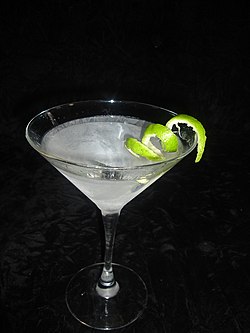
A garnish is an item or substance used as a decoration or embellishment accompanying a prepared food dish or drink. [1] In many cases, it may give added or contrasting flavor. Some garnishes are selected mainly to augment the visual impact of the plate, while others are selected specifically for the flavor they may impart. [2] This is in contrast to a condiment, a prepared sauce added to another food item primarily for its flavor. A food item which is served with garnish may be described as being garni, the French term for "garnished."
Contents
- Overview
- List of garnishes
- Foods and entree
- Desserts and sweets
- Beverages
- Garnishes according to cuisine traditions
- French garnishes
- Indonesian garnishes
- Japanese garnishes
- Korean garnishes
- Garnish tools
- Gallery
- See also
- References
- External links
The difference between garnish and decoration, is garnish is edible. For example, plastic grass for sushi presentation is considered a decoration, not a garnish.
















